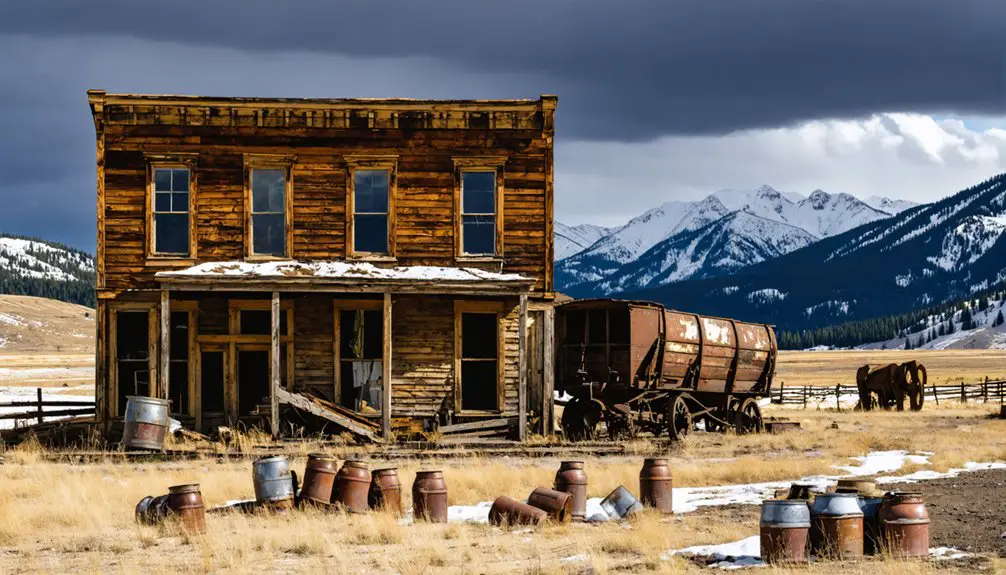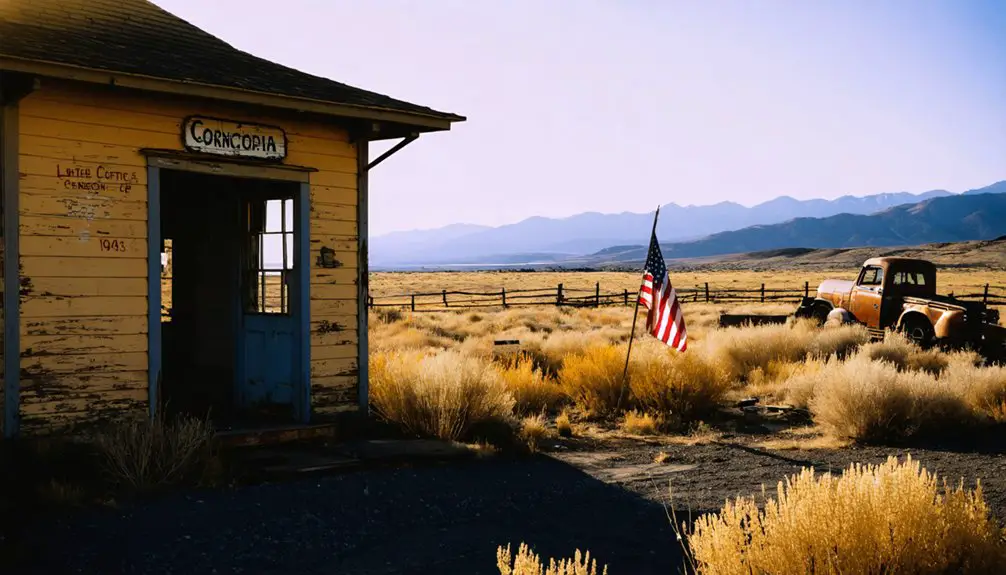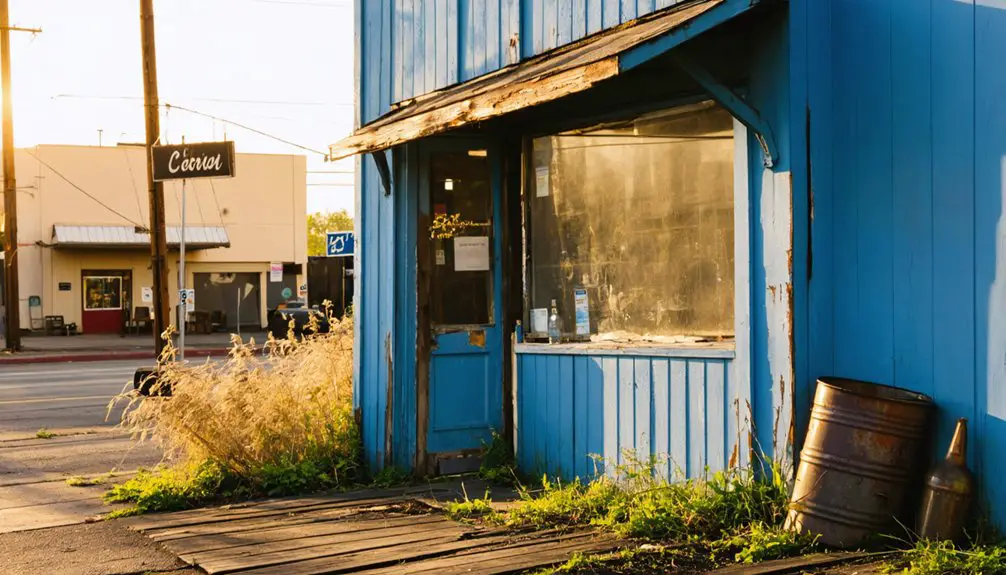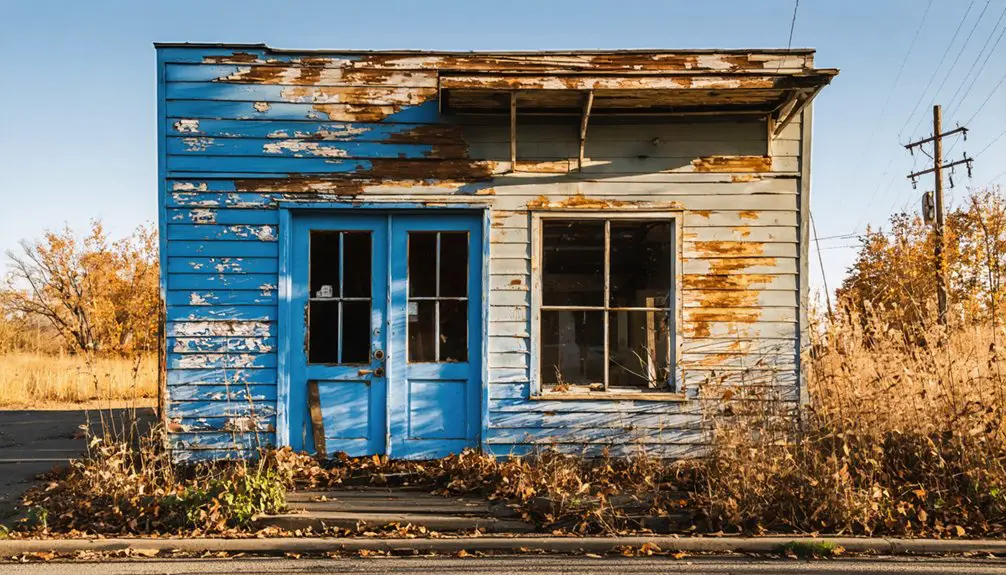You’ll discover the ruins of Cornucopia, one of Oregon’s richest gold mining towns, tucked away in the Wallowa Mountains. From its 1884 founding through 1942, miners extracted over 300,000 ounces of gold, with the town reaching 700 residents at its peak. While the Great Depression briefly halted operations, Cornucopia rebounded until World War II’s mining ban forced its closure. Today, this ghost town’s weathered remains tell fascinating tales of fortunes won and lost.
Key Takeaways
- Cornucopia was a thriving gold mining town in eastern Oregon, discovered in 1884 and reaching its peak population of 700 residents by 1900.
- The town operated sixteen productive mines that yielded 300,000 ounces of gold, with total mining output reaching $18 million by 1939.
- The Great Depression devastated Cornucopia, reducing its population to just 10 residents by 1930, though mining operations briefly resumed in 1934.
- Roosevelt’s 1942 wartime order to close gold mines as “non-essential” operations delivered the final blow to Cornucopia’s economy.
- Steep terrain, harsh weather, and geological challenges in the Wallowa Mountains complicated mining operations throughout Cornucopia’s history.
A Rich Mining Heritage: The Birth of Cornucopia
When Lon Simmons discovered gold near Oregon’s eastern border in 1884, he sparked a mining rush that would transform Pine Creek into the legendary town of Cornucopia.
By mid-1885, you’d have found nearly 500 miners working the area, employing both hydraulic placer mining techniques and traditional lode mining to extract the precious metal.
The settlement, named after the mythical horn of plenty, quickly absorbed neighboring camps like Allentown and became a hub for major mining operations. Like the goddess of fortune Fortuna, the town seemed blessed with endless riches during its peak years.
Companies like Last Chance, Queen of the West, and Union-Companion established historical landmarks across the landscape, with Cornucopia Mines of Oregon emerging as the region’s powerhouse.
The operation grew so substantial that it ranked as the sixth-largest mining operation in America during the early 1900s, employing up to 700 workers. The mines produced an impressive 300,000 ounces of gold over their lifetime, with experts believing that much more remains untapped.
Gold Rush Glory Days: Peak Population and Prosperity
During Cornucopia’s golden age in the early 1900s, the bustling mining town reached its zenith with roughly 700 residents, making it one of America’s largest mining settlements. The town managed to survive the Depression while many other mining communities failed.
This historical significance was backed by an impressive mining output that totaled approximately $18 million in precious metals, with the ghost town’s mines accounting for 66% of Oregon’s gold production by 1939.
You’ll find these remarkable achievements from Cornucopia’s heyday:
- Record-breaking monthly profits reaching $100,000 in 1938
- Sixteen productive mines yielding 300,000 ounces of gold
- Two major operations: Union Companion and Last Chance mines
The town thrived with multiple businesses, including general stores, saloons, and a hotel, while miners worked intensive 10-hour days. The miners adopted cyanidation methods to improve metal recovery from the ore.
Despite harsh winters at 4,000 feet elevation, the community’s spirit remained unbroken during these prosperous times.
The Town’s Unique Dual Settlement Structure
You’ll find Cornucopia’s settlement uniquely split between its steep mining zones and the more accessible residential areas below.
The town’s challenging topography forced mining operations and worker housing onto precarious cliffside locations, while community life centered in the valley’s safer terrain. Local residents can now visit the restored historic jail, showcasing the town’s rich history. Today, visitors must traverse gravel roads to reach the former mining area.
This physical division shaped daily routines, as miners navigated treacherous trails between their elevated workplaces and the town’s social hub below, especially during harsh winter months.
Old Versus New Settlements
Although most mining towns developed as single settlements, Cornucopia emerged with a distinctive dual-town structure around 1885. When you’d visit these neighboring communities, you’d find the old town was more established, with two general stores, a hotel, and a proper schoolhouse serving 65 pupils.
The new town, just a quarter-mile away, took shape with its own character, even holding classes in a converted saloon. The town reached its peak with 700 working miners employed at the Union-Companion mine during its most productive years. The miners faced treacherous conditions as they operated the aerial tram that transported ore from mines thousands of feet above the town.
Key differences between the settlements:
- The old town featured formal infrastructure, including a dedicated post office and school building.
- The new town adopted a more makeshift approach, repurposing buildings for community needs.
- Both areas maintained separate commercial districts with their own saloons and boardinghouses, reflecting the competing mining companies’ influence.
Mining Companies Drive Division
While several mining companies operated in Cornucopia by the 1900s, four major players – Last Chance, Queen of the West, Union-Companion, and Red Jacket – shaped the town’s distinctive dual settlement structure.
You’ll find that corporate competition between these companies created physical and social divisions, as each operation established its own camps and facilities around their respective claims.
The mining giants employed up to 700 workers collectively, making Cornucopia America’s sixth-largest mining operation.
This workforce concentration reinforced the social hierarchy, with company-specific housing and infrastructure keeping different mining camps separate.
You can trace how these divisions affected everything from mill access to transportation resources, as each company maintained its own facilities.
The resulting split settlement pattern defined Cornucopia’s unique development and community dynamics.
The companies relied heavily on locally milled lumber to construct their extensive infrastructure and facilities.
Mining Operations and Golden Fortunes
After Lon Simmons discovered gold in Cornucopia in 1884, the area quickly transformed into one of Oregon’s most significant mining operations.
By the early 1900s, you’d find over 700 workers operating in what became the nation’s sixth-largest gold mining venture, showcasing Oregon’s hidden wealth.
Here’s what made Cornucopia’s mining operations extraordinary:
- A twenty-stamp mill crushed 60 tons of ore daily
- Aerial tram systems conquered harsh winter terrain
- The mines yielded $7 million in gold over 40 years
The historic gold mining town reached its peak in 1940, employing the latest technology like electrification and pneumatic drills.
You can still trace Cornucopia’s historical preservation through its remaining structures, reflection of a time when this horn of plenty produced 66% of Oregon’s gold output.
The Great Depression’s Impact on Cornucopia

When the Wall Street Crash hit in 1929, Cornucopia’s bustling mining operations came to an abrupt halt, causing the town’s population to plummet from hundreds to just ten residents by 1930.
You’d have witnessed widespread economic devastation throughout Eastern Oregon during this period, as mining communities saw their incomes slashed by half between 1929 and 1932. Many residents, like countless others across Oregon, had to leave in search of better opportunities elsewhere.
Despite these initial setbacks, you’ll find that Cornucopia’s mines managed to resume operations by 1934, though the town’s ultimate recovery would prove short-lived.
Population Plummets to Ten
The devastating Wall Street Crash of 1929 dealt Cornucopia a near-fatal blow, causing its population to plummet from several hundred residents to just ten people by the 1930 census.
The gold mining town’s economic despair mirrored the nationwide chaos of the Great Depression, as mining operations ground to a halt and gold prices collapsed.
Despite signs of community resilience, you’d have witnessed:
- Businesses and social functions shuttering their doors as residents fled
- A once-bustling mining town reduced to isolated households struggling to survive
- The stark transformation of a thriving community into a shell of its former self
The dramatic population decline marked a turning point in Cornucopia’s history, though the town would experience a brief revival in the mid-1930s before its final decline during World War II.
Mining Operations Grind Halt
Mining operations crumbled across Cornucopia following Wall Street’s devastating 1929 crash, bringing the town’s economic engine to an abrupt halt.
You’d have witnessed most miners fleeing the area as gold production virtually ceased, leaving behind dormant mines and a decimated local economy.
When operations finally resumed in the mid-1930s, you’d have seen remarkable changes in mining technology, with new mine cars and expanded mill capacity reaching 400 tons daily.
Despite labor challenges that demanded grueling 10-hour shifts for miners and 12-hour days for mill workers, the town’s resilience paid off.
Economic Recovery Attempts Fail
Despite attempts to revive Cornucopia’s economy after the 1929 Wall Street crash, you’d have witnessed devastating and lasting impacts throughout the 1930s. The town’s population plummeted to just 10 residents by 1930, while Oregon’s broader industries lost over one-third of their workforce.
Economic policies and labor migration patterns created additional challenges, as Dust Bowl refugees flooded the region seeking work.
Key developments that shaped Cornucopia’s struggle:
- Mining operations briefly resumed in 1934, pushing profits to $100,000 monthly by 1938.
- Population rebounded to 352 by 1940, showing temporary recovery.
- Roosevelt’s 1942 wartime policies forced gold mines to close, dealing the final blow.
Despite a brief mining revival in the 1980s under nuclear corporation management, Cornucopia never regained its economic footing.
World War II and the Beginning of the End

When President Franklin D. Roosevelt ordered the closure of all gold mines in early 1942, he delivered a fatal blow to Cornucopia’s thriving economy. The government deemed gold mining “non-essential” during wartime, prioritizing metals like copper, iron, and aluminum for the war effort instead.
You’d hardly recognize Cornucopia before these wartime restrictions took effect. The town had rebounded impressively from the Great Depression, with its mines producing 66% of Oregon’s gold by 1939 and ranking seventh nationally in production. Monthly profits reached $100,000, and the population had grown to 352 residents.
But the mining ban triggered an immediate economic collapse. Workers scattered to war-related industries, while southeastern Oregon shifted its focus to lumber and beef production.
Cornucopia never recovered, transforming from a bustling mining town into the ghost town you’ll find today.
Natural Challenges in the Wallowa Mountains
The rugged Wallowa Mountains presented significant geological obstacles to Cornucopia’s mining operations, with their complex mix of metamorphic rocks and granitic intrusions formed over 130 million years ago.
Ancient metamorphic formations and granite masses shaped the Wallowas over millions of years, creating steep challenges for Cornucopia’s miners.
You’d encounter steep slopes prone to rockslides and unstable glacial deposits that complicated mining activities, while harsh alpine conditions at nearly 10,000 feet created constant natural obstacles.
Three major challenges you’d face in the Wallowas:
- Rapid weather changes and high winds at elevation that’d halt operations
- Spring snowmelt causing flash floods and erosion challenges in the mines
- Unstable terrain from Columbia River Basalt layers that’d threaten tunnel stability
The mountains’ complex watershed system, fed by the Wallowa, Minam, and Imnaha rivers, created additional hazards through seasonal flooding and sediment deposition.
Modern Day Adventures in a Historic Ghost Town

Modern-day visitors to Cornucopia can explore one of Oregon’s most fascinating ghost towns through a mix of guided experiences and self-directed adventures.
You’ll find comfortable lodging at the Cornucopia Lodge or cozy wood-paneled cabins while planning your historic exploration of the area’s rich mining heritage.
Trek through remnants of mines and abandoned houses on foot, or saddle up for horseback rides through the surrounding forest.
In winter, you can carve through snow-covered terrain on skis or snowmobiles.
The site’s dual mining districts showcase $7 million worth of gold production history, with interpretive opportunities bringing to life tales of legendary strikes and lost fortunes.
Remember to exercise caution around structural ruins and prepare for rapid weather changes during your outdoor adventures in this 4,700-foot elevation ghost town.
Frequently Asked Questions
Are There Any Paranormal Activities Reported in the Abandoned Buildings?
You’ll find numerous ghost sightings, including unexplained footsteps, voices, and shadowy figures in these haunted locations. Visitors report temperature drops, strange lights, and orbs throughout the deteriorating mining-era buildings.
What Happened to the Mining Equipment After the Town Was Abandoned?
You’ll find most mining equipment was abandoned in place after the 1942 closure, becoming historical preservation sites. The rugged terrain and harsh winters made removal too difficult and costly.
Can Visitors Take Home Artifacts They Find in Cornucopia?
Even if you discover the world’s most amazing relic, you can’t take artifacts home. Federal and state laws protect Cornucopia’s historical significance through artifact preservation, with hefty penalties for removing items.
Are There Any Descendants of Original Cornucopia Miners Still Living Nearby?
While local legends suggest some families stayed in the region, there’s no confirmed record of original miners’ descendants living nearby today. You’d need to dig through family histories to verify.
How Safe Are the Old Mine Tunnels for Modern Exploration?
You shouldn’t explore these mine tunnels – they’re extremely dangerous. Unstable supports, toxic gases, old explosives, and sudden cave-ins pose lethal risks. No tunnel exploration is safe without professional mine safety equipment.
References
- https://www.islands.com/1914381/eastern-oregon-gold-rush-boom-town-cornucopia-remarkably-picturesque-abandoned-ghost-town-today/
- https://en.wikipedia.org/wiki/Cornucopia
- https://westernmininghistory.com/towns/oregon/cornucopia/
- https://www.cornucopialodge.com/area-history-info
- https://www.youtube.com/watch?v=CMhEz6GJHlo
- https://digging-history.com/2015/11/24/ghost-town-wednesday-cornucopia-oregon/
- https://archiveswest.orbiscascade.org/ark:80444/xv84936
- https://bakercityherald.com/2023/03/24/golden-cornucopia-documentary-explores-history-of-baker-countys-richest-mining-district/
- https://lagrandeobserver.com/2023/03/27/golden-cornucopia-documentary-explores-history-of-baker-countys-richest-mining-district/
- https://goeasternoregon.com/2025/08/08/history-talk-planned-aug-16-in-cornucopia/



